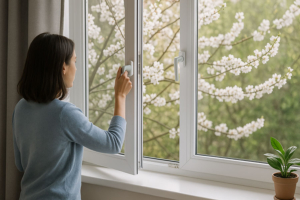How to Improve Indoor Air Quality in the Spring
 As the seasons change and spring arrives, many homeowners notice an increase in allergies, dust, and airborne irritants inside their homes. Warmer temperatures and blooming plants bring pollen and other allergens that can significantly impact indoor air quality. If you or your family members experience sneezing, itchy eyes, or respiratory discomfort during this time of year, taking proactive steps to improve your home’s air quality can make a big difference.
As the seasons change and spring arrives, many homeowners notice an increase in allergies, dust, and airborne irritants inside their homes. Warmer temperatures and blooming plants bring pollen and other allergens that can significantly impact indoor air quality. If you or your family members experience sneezing, itchy eyes, or respiratory discomfort during this time of year, taking proactive steps to improve your home’s air quality can make a big difference.
From upgrading air filtration to maintaining proper ventilation, here are the best ways to keep your indoor air fresh and clean this spring.
Understanding Springtime Indoor Air Quality Challenges
Spring is a time of renewal, but it also brings an influx of allergens and pollutants that can impact your home’s air. The most common issues affecting indoor air quality in the spring include:
- Pollen – Trees, grasses, and flowers release pollen that can easily enter your home through open windows, doors, and even on your clothing.
- Dust and Pet Dander – Warmer temperatures and increased activity inside the home can lead to more dust and pet dander accumulation.
- Mold Growth – Increased humidity levels in the spring create an ideal environment for mold spores to thrive, especially in damp areas like basements and bathrooms.
- Poor Ventilation – Homes that are tightly sealed for energy efficiency may trap allergens and pollutants inside, leading to stale or contaminated indoor air.
By understanding these challenges, homeowners can take the necessary steps to combat poor indoor air quality and create a healthier home environment.
Practical Tips for Improving Indoor Air Quality
1. Upgrade Your Air Filtration System
One of the most effective ways to improve indoor air quality is by using high-quality air filters in your HVAC system. Standard filters may capture larger dust particles, but high-efficiency particulate air (HEPA) filters can trap smaller allergens like pollen, mold spores, and pet dander.
- Replace HVAC filters every one to three months during peak allergy seasons.
- Consider HEPA filters or electrostatic filters for better air purification.
- Use portable air purifiers in bedrooms or living areas for additional filtration.
2. Keep Windows and Doors Closed During High Pollen Days
While fresh air is beneficial, springtime pollen can make allergies worse. To reduce pollen exposure inside your home:
- Check daily pollen counts and keep windows closed when levels are high.
- Use air conditioning instead of opening windows for cooling.
- Install weather stripping to seal gaps around doors and windows, preventing allergens from entering.
3. Improve Home Ventilation
Proper ventilation helps remove stale air and prevent the buildup of indoor pollutants. If your home is well-sealed, consider ways to increase airflow while keeping allergens at bay.
- Use exhaust fans in the kitchen and bathrooms to reduce humidity and pollutants.
- Install a whole-house ventilation system to improve air circulation.
- Open windows on low-pollen days to let in fresh air.
4. Reduce Indoor Allergens with Regular Cleaning
Routine cleaning is key to maintaining good indoor air quality in the spring. Dust, pet dander, and pollen can accumulate on surfaces, carpets, and upholstery, making allergy symptoms worse.
- Vacuum carpets and rugs at least twice a week using a vacuum with a HEPA filter.
- Dust surfaces with a damp cloth to trap and remove allergens.
- Wash bedding, curtains, and pet bedding regularly to eliminate dust and dander.
5. Control Indoor Humidity Levels
Excess humidity can encourage mold growth and make indoor air feel heavy or musty. Keeping humidity levels between 30-50% can prevent mold spores from spreading and help maintain a comfortable indoor environment.
- Use a dehumidifier in damp areas like basements and bathrooms.
- Fix any leaks or water damage to prevent moisture buildup.
- Run an air conditioner or ceiling fans to help regulate indoor humidity.
6. Invest in an Air Purifier
Air purifiers can be a great addition to your home, especially if you suffer from allergies or asthma. These devices help remove airborne pollutants and allergens, improving indoor air quality.
- Choose an air purifier with a HEPA filter for maximum effectiveness.
- Place purifiers in high-traffic areas like bedrooms and living rooms.
- Consider models with activated carbon filters to remove odors and volatile organic compounds (VOCs).
7. Schedule Seasonal HVAC Maintenance
A well-maintained HVAC system plays a crucial role in indoor air quality. Spring is the perfect time to have your system inspected and cleaned before the heat of summer arrives.
- Have a professional inspect and clean your air ducts, coils, and vents.
- Check for mold growth or excessive dust buildup in your HVAC system.
- Ensure your air conditioner is running efficiently to prevent humidity issues.
8. Bring in Indoor Plants for Natural Air Purification
Certain houseplants can help improve indoor air quality by filtering pollutants and adding oxygen to the air. Some of the best air-purifying plants include:
- Snake plant – Removes toxins like formaldehyde and benzene.
- Peace lily – Helps reduce mold spores and absorbs airborne pollutants.
- Spider plant – Naturally filters out common indoor contaminants.
While plants can enhance air quality, be mindful if you have allergies, as some can produce pollen.
Breathe Easier This Spring
Spring doesn’t have to mean suffering from poor indoor air quality. By taking proactive steps like upgrading air filters, improving ventilation, and keeping allergens under control, homeowners can create a healthier indoor environment for their families.
If you need assistance with HVAC maintenance, air filtration solutions, or improving your home’s ventilation system, Jacobs and Rhodes is here to help. Our expert technicians can recommend the best solutions to keep your indoor air clean and comfortable all year long.
Contact us today to schedule an HVAC inspection or learn more about air quality solutions for your home!
Contents
- 1 Understanding Springtime Indoor Air Quality Challenges
- 2 Practical Tips for Improving Indoor Air Quality
- 2.1 1. Upgrade Your Air Filtration System
- 2.2 2. Keep Windows and Doors Closed During High Pollen Days
- 2.3 3. Improve Home Ventilation
- 2.4 4. Reduce Indoor Allergens with Regular Cleaning
- 2.5 5. Control Indoor Humidity Levels
- 2.6 6. Invest in an Air Purifier
- 2.7 7. Schedule Seasonal HVAC Maintenance
- 2.8 8. Bring in Indoor Plants for Natural Air Purification
- 3 Breathe Easier This Spring


